Abstract
Alkali-activated binders have become popular in the construction industry for their eco-friendly attributes. Various wastes from industries and agricultural sectors containing high concentrations of aluminosilicate and calcium oxides can be used to design these binders. This study evaluated the effect of high-volume granulated blast furnace slag, fly ash, and palm oil fuel ash additions on the bond strength performance of the proposed geopolymer mortars. Various levels of slag (50, 60, and 70%) and fly ash were substituted by palm oil fuel ash to determine the impact of SiO2:Al2O3, CaO:SiO2, and CaO:Al2O3 and their proportions on the geopolymerization process and the strength performance of the designed mortars. The bond strength performance of the mortars was assessed in terms of slant shear, flexural, and splitting tensile strength tests. The mineral properties of the designed mortars were obtained using X-ray diffraction, scanning electron microscopy, and Fourier transform infrared measurements. The incorporation of fly ash and palm oil fuel ash in the mortars caused a considerable decrease in the CaO:SiO2 and CaO:Al2O3 ratios, thus reducing the geopolymerization process and strength performance. The reduction in slag from 70% to 50% was counterbalanced by the increasing content of fly ash and palm oil fuel ash, which led to a drop in the compressive strength from 97 MPa to 56 MPa. In each level of slag, the replacement of fly ash by up to 10% palm oil fuel ash added more loss in strength values. In addition, the surface morphology of prepared mortars with lower palm oil fuel ash content was significantly enhanced, indicating the presence of less porosity and unreacted particles. The achieved mortars were asserted to be extremely well matched with the concrete substrates, offering effective binders for widespread construction uses.
1. Introduction
In the world, ordinary Portland cements are the main materials used to produce concrete in the construction industry. It is well known that these concrete structures gradually deteriorate due to environmental and manmade effects. To overcome this issue, numerous costly mortars and binders have been developed and are commercially accessible for repair, maintenance, and rehabilitation purposes. Lately, geopolymer mortars (GPMs) as alternative repair materials have received significant attention. These types of materials are tested in terms of the parameters influencing the behavior of the product, reaction mechanisms, and mechanical characteristics, particularly the compressive strength and bonding between conventional concrete and GPMs [1,2].
Recently, various geopolymers (GPs) that have been introduced for the repair of concrete surfaces have received growing research attention [3,4,5]. In the exploitation of the GPs as a new repairing substance, the binding efficacy between the concrete materials and the repairing substances [6,7] plays a decisive role. Geopolymer materials are well-matched with ordinary Portland cement (OPC)-based concretes due to their closeness of different characteristics, including the elastic modulus, compressive strength, flexural strength, splitting tensile strength, and Poisson’s ratio [8]. Furthermore, GPMs have the ability to be repaired at the same ambient temperature as traditional concrete [9]. These notable characteristics of GPMs make them prospective for repairing concrete surfaces. In spite of many studies, the durability performance of GPMs for repair purposes has not been assessed comprehensively.
The vast amount of diverse wastes from nature, industries, and agricultural sectors, like fly ash (FA) [10], coals and by-products from burnt oils, bottom ash [11], palm oil fuel ash (POFA) [12], rice husk ash [13], bagasse ash [14], waste glass [15], waste tires [16], cement dust [17], waste marble [18], crushed stones [19,20], ground blast furnace slag (GBFS) [21], waste ceramics [22], etc., are discarded annually as landfill in all developing nations. Disposal of these wastes became a serious environmental concern (responsible for air, water, and soil pollution) unless inhibited. Many investigations showed that such waste materials could be effectively reused by almost 70% to make novel mortars/binders/concrete structures as a potential substitute for OPC. In addition, new types of concrete made of these waste materials are green, eco-friendly, relatively cheap, and durable. So far, the production of various GPMs as repair components, especially for deteriorated concrete surfaces, by containing the abovementioned wastes has rarely been explored.
A large amount of agro-industrial waste is available in palm oil-producing countries in East Asia, such as Malaysia, Indonesia, and Thailand, where POFA is a by-product of the palm oil industry. In addition, this production rate is likely to increase because of the increased plantation of palm oil trees. POFA is derived by burning empty fruit bunches, oil palm clinkers, and shells for electricity generation. Interestingly, POFA, having no market value, is simply dumped into ponds or lagoons as land filler [23], which remains a serious environmental concern. However, several research studies [24,25] have shown that POFA, being rich in SiO2 content, can be beneficial for concrete production in terms of sustainable development. Such advancements added further research impetus towards the intensive use of this cheap and abundantly available material (POFA). Yet, POFA is being classified as a pozzolanic substance [26] and can be used for the partial substitution of OPC in traditional concrete to enhance its strength and durability [27] or as a GPs binder [28,29,30].
Understanding the mechanism of controlling the alkali activation in mortars has been reported through repeated research studies [31,32,33,34,35]. However, not many studies have been conducted to understand alkali activation in aluminosilicates (ASs) to achieve high-performance GPMs, which is a relatively recent research domain compared to conventional OPC-based concretes. The activation of alkaline solutions in aluminum silicates is distinct from that in hydrated OPCs in terms of upper preliminary alkalinity and being free of lime. These hydrated substances are distinct from several other products. Thus, depending on the chemical pathways of OPC-based products, it is very difficult to make proper predictions about the characteristics of alumino silicates that are activated by alkaline solutions. The major binding stage of hydrated OPC is a gel called calcium aluminum silicate hydrate (C-A-S-H). Conversely, the foremost outcome of alkaline solution-activated substances is the sodium aluminum silicate hydrate gel called N-A-S-H. Therefore, it is important to gain an in-depth understanding of the N-A-S-H gel development mechanism.
Some studies revealed that the calcium contents of FA can significantly affect the resulting hardened states of GPMs [36]. Its CaO generates calcium silicate hydrate (C-S-H) and C-A-S-H gels. However, these geopolymers should be cured at high temperatures for practical applications. Previously, researchers aimed to enhance the reactivity of these materials by incorporating various calcium-based compounds [37]. Essentially, the addition of CaO facilitates the development of C-S-H gel and C-A-S-H network structures. CaO contents in the precursors could play an important role in achieving the final setting time of geopolymers. Aside from that, an increase in CaO concentration is found to enhance the mechanical strengths and reduce the setting times. The compatible nature of C-(A)-S-H and N-A-S-H gels has a significant influence on the hybrid OPC and alkaline solution activated aluminum-silicate systems, wherein both products could be obtained [38]. In the past, various synthetic gels were used to study the influences of elevated pH levels on every component of the formed gels. Aqueous Al2O3 could appreciably influence the development of C-S-H products [39]. Additionally, aqueous calcium could modify the N-A-S-H gel and partly replace sodium with calcium to generate (sodium calcium) aluminum silicate hydrate gel [39]. However, the gel development mechanism and consequent improvement in the properties of GPMs still remains unclear. Hence, to determine the possibility of obtaining some effective materials alternative to OPC for construction purposes, an in-depth analysis is necessary to understand the co-existence and compatibility of N-A-S-H and C-A-S-H gels.
Usually, concrete repairing processes, although expensive, are carried out using the available repair materials, having excellent compressive strength and bonding strength [40]. Thus, less costly substitute repairing materials with analogous attributes are sought. Several researchers [41,42,43,44] attempted to employ geopolymers as repairing systems due to their good slant and direct shear strengths as well as pull-out properties. Hu et al. [41] investigated the bond strength of mortar substrates with geopolymer systems where the later revealed higher bond strength than the conventional cement mixture. Phoo-ngernkham et al. [42] evaluated the bond strength of concrete substrates with GPM prepared by using wastes from a Tungsten mine comprising Ca(OH)2. It was observed that GPM binders possessed a higher early age bond strength than commercial repairing materials. Songpiriyakij et al. [43] evaluated the bond strength of substrate concrete with rebars using geopolymer as the binding media. It was reported that the bond strength of geopolymers incorporating rice husk ash and silica fume was nearly 1.5 times higher than the epoxy. Accordingly, the bond strength of geopolymers was adequately higher, indicating their compatibility as a substitute binding agent towards repairing works in the civil engineering field.
The slant shear load carrying ability of cement and repair components measured at 45° ranged from 11.8 to 26.2 MPa and was higher than GPMs (ranged from 14.2 to 24.2 MPa). The mixes prepared with 10 M and 14 M NaOH revealed considerably higher slant shear bond strength (SSBS) than the other repair materials. This showed that GPM with OPC as an additive and as a repairing agent can be a prospective option [45]. It was also observed [36] that the SSBS of GPM can be higher than commercial repair products. The slant shear ability of an OPC-based concrete substrate and geopolymer at 45° of the interfacial line to normal was evaluated. The values of the bond strength increased with the increase in GBFS level. Phoo-ngernkham et al. [45] studied the influence of various NaOH molarities (6, 10, and 14 M) on the SSBS development of GPMs where they showed better bond strength performance at 10 M NaOH (NH) as a repairing agent. The bond strength of GPMs reduced with the reduction in NH molarity. In addition, at higher NH molarity, the bond strength of GPMs containing higher levels of CaO was reduced [36,45]. The effects of various solutions on the process of alkali activation of various wastes were also studied [36], wherein alkali activators like NH, sodium silicate (NS), and NH-NS were used. The bond strength value of GPMs prepared with NH-NS was higher than those of NH or NS alone. Zhang et al. [46] studied the impact of various proportions of SiO2 to Al2O3 on the SSBS development of GPMs wherein the mixes prepared with a lower ratio of silica to aluminum showed a reduced bond strength at ambient temperatures and were higher at higher temperatures.
Zhang et al. [46] examined the influence of various SiO2 to K2O proportions on the slant bond strength of geopolymers. The bond strength increased slightly with the decrease in alkali activator ratio. The alkali activator solution was made by mixing KOH flakes with K2SiO3 solution. The reduction in SiO2 to K2O ratio caused an increase in the KOH contents of the resultant solution. Hu et al. [41] studied the impact of GBFS substitution (0 and 20%) on metakaolin-based geopolymers which showed better repairing traits compared to OPC-based mortars. In addition, the incorporation of GBFS could appreciably improve the bond strength of the proposed geopolymers. Amongst all the commercially available repairing materials, GPMs prepared with 100% metakaolin and geopolymers containing 20% of GBFS are suitable for repair applications. The influence of ply-wood ash and rubber wood ash as a substitution for metakaolin on the bond strength in OPC-based mortars was also examined [47], which showed that the former enhanced the bond strength of mortar remarkably. Based on the huge demand of various recycled waste material-based GPMs with improved bond strength performance, the present study examined the incoporation of high volumes of GBFS, FA, and POFA and the role on the engineering properties of the new types of GPMs.
2. Materials and Methods
2.1. Physicochemical and Mineral Characteristics of Constituents
Agriculture and industrial by-product wastes, namely POFA, FA, and GBFS, were utilized to produce eco-friendly alkali-activated binders. POFA is a waste material produced from palm oil fibres, bunches, and shells as fuel for power generation in mills. It was obtained from an oil palm mill located in Johor (Malaysia) and separated from an ash outlet which is kept away from the boiler burning chamber (Figure 1). Firstly, it was sieved through 600 µm to remove the large particles, followed by drying in an oven at 105 °C for 24 h to remove free water. It was again sieved through 300 µm to improve the ash efficacy. The 300 µm obtained ash was then ground to fine particles for 6 h (Los Angeles Abrasion machine containing 15 stainless balls, each 50 mm diameter at 32–35 rpm). The finesse of particles was greatly influenced by the rpm that was checked at each hour interval. The proportion of particles maintained on 45 µm sieve was decreased with the period of grinding. After complete grinding, the entire ash was passed through 45 µm sieve.
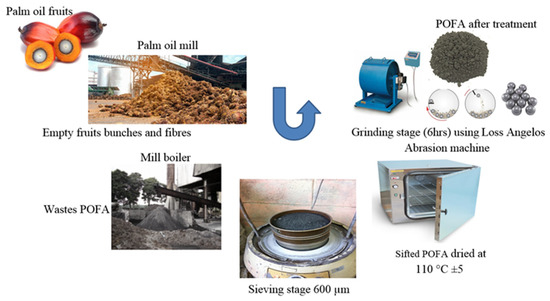
Figure 1.
POFA treatment and processing including collection, sieving, drying, and grinding [48].
As the main source for aluminosilicate, FA (low CaO) was collected (Malaysian power station) to prepare GPMs. It satisfied the ASTM C618 standard of pozzolan (N class) and FA (F class) with grey appearance. The chemical composition of FA (using X-ray fluorescence test) showed that the primary oxide elements present in it were aluminium and silica, the total of which were 86%. Table 1 presents the physical and chemical properties of utilized FA, POFA, and GBFS. The main composition of oxides (silica and aluminium) were 86% FA, 68.45% POFA, and 41.7% GBFS. The contents of potassium oxide (K2O) were found to be very low in FA and GBFS but high in POFA. Moreover, POFA displayed a higher (1.8%) loss on ignition (LOI) which was consistent with the ASTM C618 standard. As the main source for CaO, GBFS (possessing both cementitious and pozzolanic charactertitics with off-white appearance) was collected (Malaysia) and used without further treatment to design the binders. The occurrence of hydraulic reactions when mixed in water imparted off-white color in GBFS. GBFS was composed of approximately 90% CaO, SiO2, and Al2O3, meeting the requirements of pozzolanic components as per ASTM C618 (Table 1). The values of specific gravity, median particle size, and specific surface area of GBFS were 2.89 g/cm3, 12.8 µm, and 13.6 m2/g, respectively.

Table 1.
Chemical composition (using X-ray fluorescence test) and physical properties of POFA, FA, and GBFS.
X-ray diffraction (XRD) is non-destructive technique used to obtain the differentiation between the crystalline and amorphous phases in the materials. The test provides information especially on structures, phases, preferred crystal orientations, and structural parameters. In this study, a Siemens Diffractometer D5000 with X-ray source of Cu Kα radiation was used. The scan step was 0.02° using a scanning rate of 0.5 °C/min and in the range 2-theta-scale from 5 to 70 degrees. From each raw material (POFA, FA, and GBFS), 5 mg of powder was collected for this test. Figure 2 shows the XRD profiles of POFA, FA, and GBFS. Both POFA and FA showed intense XRD peaks at 2θ = 15.3–29.8°, which were due to the crystalline phases of SiO2 and Al2O3. These prominent XRD peaks correspond to the crystalline phases of quartz (SiO2) and mullite (3Al2O32SiO2 or 2Al2O3 SiO2). GBFS (containing reactive SiO2 and CaO) showed strong amorphous phase without any intense XRD peak, indicating its prospective for the production of GPMs. Nevertheless, POFA and FA were incorporated in the mortars as substitutes to GBFS to surmount the low concentration of SiO2 (30.8 wt.%) in GBFS.
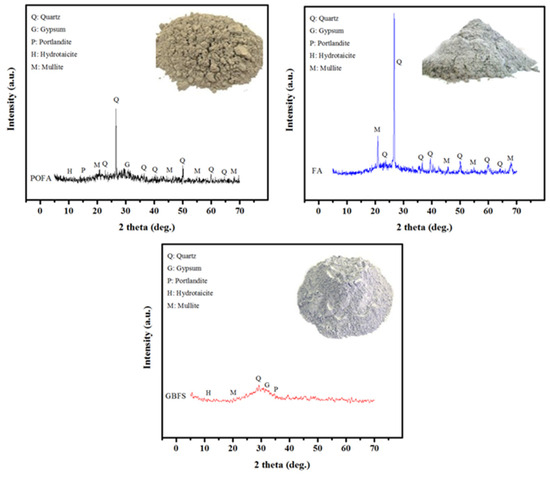
Figure 2.
XRD patterns of POFA, FA, and GBFS [49].
Figure 3 shows the SEM images of POFA, FA, and GBFS which are blended in the GPMs to achieve enhanced comprehensive strength and improved microstructural properties. It is evident that FA consisted of spherical particles (Figure 3b) with smooth surface. POFA appeared to be the combination of spherical and irregular shaped particles (Figure 3a), whereas GBFS comprised of irregular and angular particles, as shown in SEM results (Figure 3c).
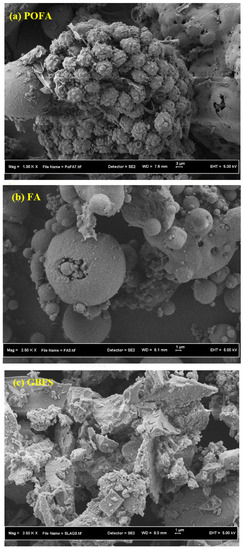
Figure 3.
SEM images of (a) POFA, (b) FA, and (c) GBFS [49].
High purity NaOH (NH) and sodium silicate (NS) mixtures composed of 29.5 wt.% of SiO2, 14.70 wt.% of Na2O, and 55.80 wt.% of H2O was used (98%, QREC). NH solution (4 M) was prepared by dissolving its pellets in water followed by cooling for 24 h and adding to NS mixture to obtain the resultant alkali solution at SiO2 to Na2O ratio of 1.02. NS to NH ratio was kept constant (0.75) for all alkali solutions. In this research study, natural siliceous river sand as fine aggregates was used to produce the mortars. ASTM C117 standard was followed to clean the obtained sand in water, reducing the presence of silts and impurities. The washed sand was oven dried (at 60 °C for 24 h) to reduce the moisture level, fulfilling the ASTM C33-33M standard. The obtained fineness modulus and specific gravity of the fine sand aggregates were 2.9 and 2.6, respectively.
2.2. Preparation of Mixes
The influence of high CaO content on the geopolymerization mechanism of the produced 15 mortar mixes were assessed (Table 2). The CaO content was improved by increasing the GBFS content (50, 60 and 70%) in the GPM blend. Then, FA and POFA were used to replace GBFS in the GPMs. Figure 4 depicts the various effects of GBFS, FA, and POFA contents on the CaO mass ratio, wherein with the increase in GBFS level from 50 to 70%, the CaO concentration increased from 28.5 to 37.8%, respectively (Figure 4). In addition, the SiO2 content enhanced by decreasing the GBFS level and increasing the POFA content. Aside from that, the concentration of Al2O3 improved by increasing the FA content. All the mixes in every batch were made with the same molarity of NH (4 M). The proportion of POFA, FA, and GBFS (binders) to fine aggregates (B:A) were maintained constant at a 1:1 ratio. All GPMs had a constant ratio of NS to NH wherein the alkaline activation containing Na2SiO3 and NaOH amounts was correspondingly 171.43 and 228.57 kg/m3. The ratio of alkaline activator solution to ternary binder of geopolymer mix was fixed at 0.40. The obtained mortar mixes were analyzed using diverse measurements to evaluate the effects of high GBFS level on their durability performance and slant shear bond strength (SSBS).

Table 2.
Compositions of prepared mixes incorporating high GBFS levels.

Figure 4.
Influence of FA and POFA inclusion on SiO2, CaO, and Al2O3 contents.
2.3. Testing Procedure
Several methods were used to evaluate the bond strength between normal concrete substrates and proposed GPMs including the slant SBS, three- and four-point flexural strength (FS), and splitting tensile strength (STS). In the first method, for the half slant shear specimens, the hardened normal concrete was slanted diagonally at an angle of 30° from the normal. As per ASTM C882, the suggested bond angle of 30° represented the failure stress that corresponded to a flat surface close to the least stress (Figure 5). Additionally, the composite cylinders with slant shear of 45° were also prepared and evaluated for this purpose. In the second method, the dummy sections of the normal concrete cylinder were bonded with GPMs at an interface thickness of 10 mm and slant of 45°. After that, it was compressed using compression machine (3000 kN capacity NL Scientific) and tested at ages of 1, 3, 7, and 28 days. The impact of high levels of GBFS and POFA as FA replacement on the slant SBS was also evaluated. At every curing age, the mean value of the tested 3 mixes was calculated.
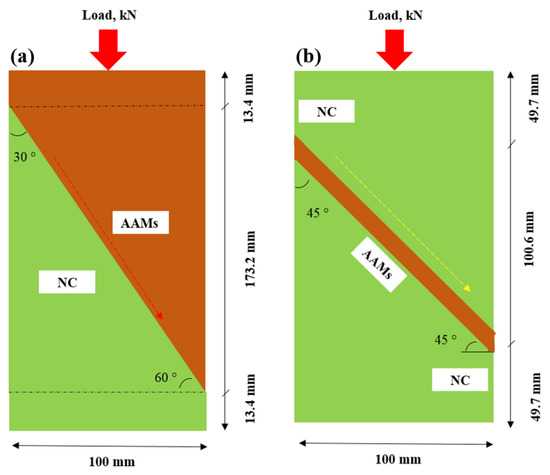
Figure 5.
Bond strength between normal concrete (NC) and GPMs for slant shear test at (a) 30° and (b) 45°.
The bond strength of GPMs is calculated by dividing the load carried by the specimen at failure by the area of elliptical bonded surface using:
where fb is the slant shear bonding strength (MPa), Fb is the maximum load carried at interface (N), and Ab is area of elliptical bond surface (mm2).
fb = Fb/Ab
An STS test of the prepared cylindrical composite materials was performed to determine the bond strength between GPMs and cement mortar substrate. The effect of POFA as an FA replacement incorporating high volumes of GBFS on the SBS of the mortar mixes was examined under the tensile strength. The tensile strength test is performed to measure the slant shear strength amid the normal concrete and the proposed mortars. Specimens are prepared by cutting the cylindrical normal concrete and forming half cylindrical specimens. Next, the half cylindrical normal concrete is placed in cylinder mould and then the fresh GPMs are poured (Figure 6). Samples are opened after 24 h and tested at ages of 1, 3, 7, 28, and 56 days. The test is conducted using compressive machine with loading rate of 2.5 kN/s.
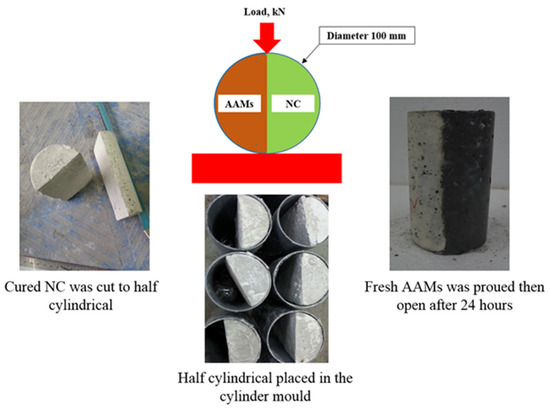
Figure 6.
Specimen preparation method for STS/SBS test.
The FS test was conducted to evaluate the bonding strength between the normal concrete and GPMs. For this test, three types of specimens are prepared. The first type of specimen is casted using OPC mortar in the form of prisms with dimensions (40 × 40 × 160) mm. After curing, they were cut into halves and then placed in steel prism mould, where the fresh GPM is poured and tested under three-point load method at ages of 1, 3, 7, 28, and 56 days. Second type of sample was made from C40 (40 Mpa) with dimensions (100 × 100 × 500) mm. It is then cut from the middle with width 35 mm and then casted in the prism mould by pouring freshly made mortars. These casted specimens were tested at ages of 1, 3, 7, 28, and 56 days under four-point load at loading rate 0.2 kN/s. The procedure for testing the two types of specimens is illustrated in Figure 7 and Figure 8, respectively.
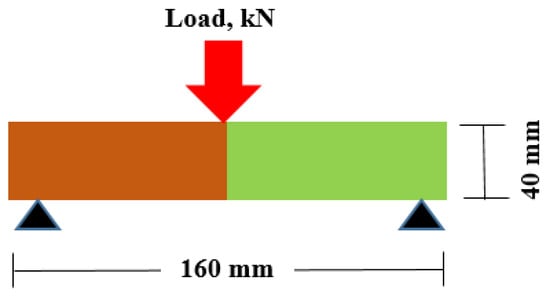
Figure 7.
Three-point FS test to evaluate the SBS between NC and GPMs.
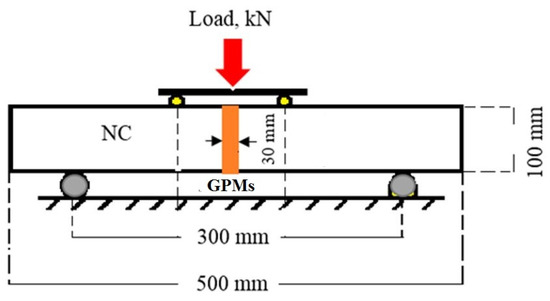
Figure 8.
Four-point FS test for SBS evaluation between NC and GPMs [50].
To evaluate the CS performance of mortars, cubic samples of size 50 mm × 50 mm × 50 mm were casted and hardening test was then performed as per ASTM C579. Following ASTM C 109, the CS tests were conducted using a load of 2.5 kN/s, wherein at least 3 mixes were tested to obtain the average values of CS at ages of 1, 3, 7, and 28 days. For microstructure tests, the prepared mortars were crushed at age of 28 days and the mid portion was ground to obtain fine powders. As reported in Section 2.1, the collected powder was scanned at rate of 0.5 °C/min and in the range 2-theta-scale from 5 to 55 degrees. XRD patterns (Rigaku, Tokyo, Japan) showed the amorphous phase of GPMs (analyzed using jade software). For the SEM test (Jeol, JSM-IT300, Tokyo, Japan), the specimens were attached on carbon tape and then dried using IR radiation for 5 min before being coated with Au layer. SEM micrographs were obtained with the tube voltage of 20 kV at the magnification of 1000×.
3. Results and Discussion
3.1. Slant Shear Bond Strength
The effect of high volume GBFS on the slant shear bond strength was assessed. Figure 9a–c depicts the 30° slant shear load carrying capacity of OPC substrates and GPMs. The slant shear values were between 4.5 and 5.2 Mpa, with increasing GBFS from 50 to 70%, as replaced with FA. At an early age (1 day), the increasing GBFS level from 50 to 70% with FA led to an increase in the bond strength from 2.1 Mpa to 2.4 and 2.6 Mpa, respectively. At every GBFS level, the bond strength values dropped slightly when the FA was replaced by POFA. Similar trends in results were observed at ages of 3, 7, and 28 days, which showed that the bond strength was positively influenced by increasing the GBFS content from 50% to 60 and 70%. At 28 days of curing age, the results showed that the increasing GBFS content from 50% to 60 and 70% led to an increase in the bond strength values from 4.5 Mpa to 4.9 and 5.2 Mpa, respectively. At 50% of GBFS, the inclusion of 10, 20, 30, 40, and 50% of POFA as an FA replacement led to a decrease in the bond strength values from 4.5 to 4.3, 4.15, 3.9, and 3.84, respectively. In high volumes of GBFS containing alkali-activated mixtures, the mixes prepared with FA exhibited significantly higher shear bond strengths than the mixes prepared with POFA. This indicated that the alkali-activated binders containing FA produce the C-S-H gel higher than the binder containing POFA. This could be due to the low content of silicate non-reactivity. However, all the GPMs achieved a bond strength much higher (almost double) than the OPC specimens.
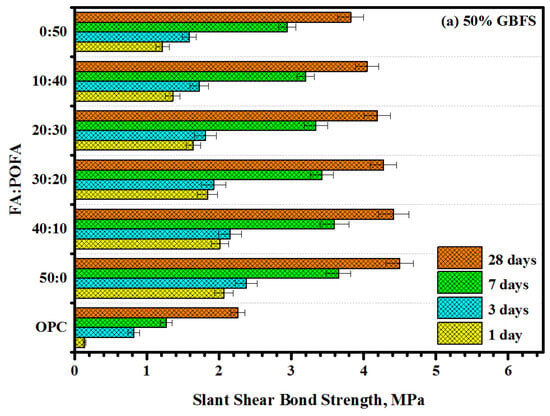
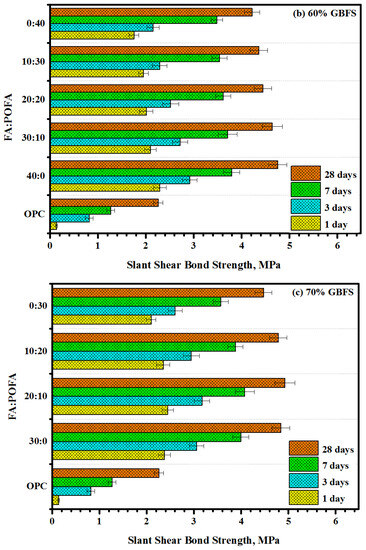
Figure 9.
Slant shear strength development of GPMs containing GBFS (a) 50%, (b) 60%, and (c) 70%.
The results of the 45° slant shear test are shown in Figure 10. An increase in the GBFS content from 50 to 60 to 70% resulted in an increase in the bond strength values from 8.5 to 9.1 to 9.6 MPa, respectively. Furthermore, the SBS dropped with the increasing replacement of FA by POFA. Increasing the level of POFA in the GPMs as a substitute to FA was found to affect the silicate and alumina levels. Thus, an increase in the silicate and a reduction in the aluminum content led to an increase in the non-reacted particles and negatively influenced the bond strength [41]. The results of 30° and 45° slant shear bond strength for all alkali-activated mixtures displayed excellent outcomes compared to the control samples of normal OPC mortar, in which case the exterior bond zone failed.
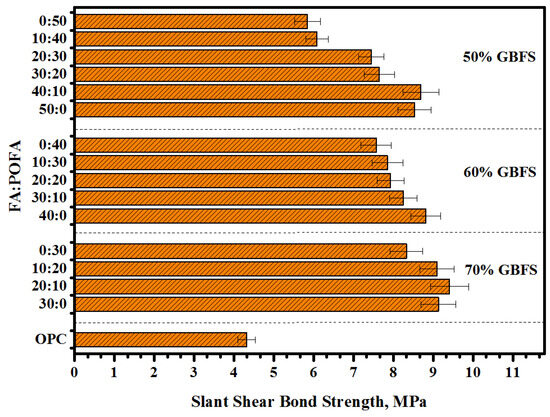
Figure 10.
45° slant shear bond strength of GPMs made with higher levels of GBFS replacing POFA and FA.
3.2. Splitting Tensile Strength (STS)
The bond strength between NC and high volume GBFS mortars was evaluated using splitting tensile strength. The results for the bond strength at an age of 28 days are shown in Figure 11. All the GPMs showed excellent SBS compared to the control sample (normal OPC substrate), wherein their values enhanced (from 2.94 to 3.11 MPa) with increasing GBFS levels (from 50 to 70%). Similar trends were found with GBFS-replaced POFA, where the bond strength increased from 2.31 to 2.73 MPa with the corresponding increase in GBFS from 50 to 70%. It was observed that the GPMs containing FA revealed a higher bond strength compared to POFA mortars. Furthermore, the SBS was reduced by increasing the POFA replacement with FA at various levels of high volume GBFS-containing alkali-activated matrices. Ranjbar et al. [29] reported that an increase in the POFA to FA percentage ratios resulted in an augmentation in the SiO2/Al2O3 ratios. Thus, the presence of a high SiO2:Al2O3 ratio restricted the C-S-H gel product formation and reduced the GPMs performance.
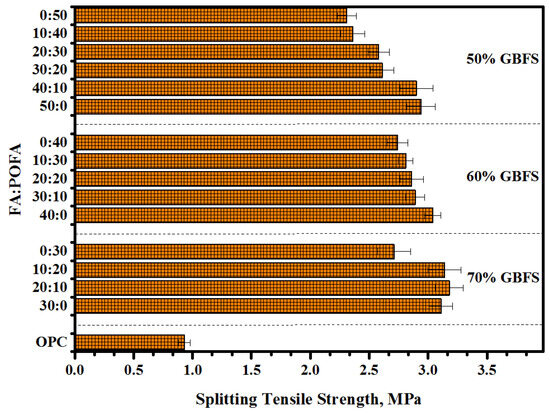
Figure 11.
Effect of 50%, 60%, and 70% of GBFS incorporating FA and POFA on GPMs’ tensile strength.
3.3. Flexural Strength (FS)
A flexural strength test was used to evaluate the bond strength between the GPMs and the OPC substrate. Two methods, including a four-point load and three-point load, were used. The influence of high levels of GBFS on the SSBS of mortar mixes was determined and the results of the flexural strength tests are discussed hereunder. Figure 12 shows the bond strength values for high volume GBFS-containing GPMs obtained using a four-point load FS measurement. The SBS values amid mortar mixes and the OPC substrate were higher than the ones obtained for the control sample (pure OPC). In addition, the values of SBS enhanced with the increase in GBFS content as a replacement of FA and POFA. The increase in GBFS levels replacing FA from 50 to 60 and 70% improved the bond strength from 1.74 to 1.86 and 1.94 MPa, respectively, as compared to 0.54 MPa for the OPC control sample. Additionally, the SBS values augmented from 1.2 to 1.65 MPa with the corresponding increase in GBFS contents from 50 to 70% in place of POFA. The bond strength was greatly influenced by the POFA to FA ratio, wherein the increase in the POFA levels led to a reduction in the SBS values. This observation was attributed to the increase in the SiO2:Al2O3 ratio and the negative impact of the reaction process involving C-S-H and C-A-S-H gel formation. All failures occurred outside the bond zone and appeared on the concrete side.
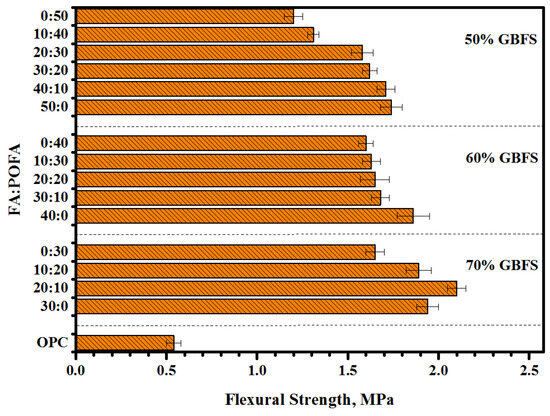
Figure 12.
Four-point load FS for GPMs at high levels of GBFS incorporating FA and POFA.
Figure 13 displays the results of the three-point load FS of GPMs. All the prepared GPMs revealed excellent bond strength between 4.37 and 5.36 MPa, as compared to the OPC control sample (1.74 MPa). Similar trends were evidenced for the SBS of GPMs, which increased with increasing GBFS contents as a replacement of FA or POFA.
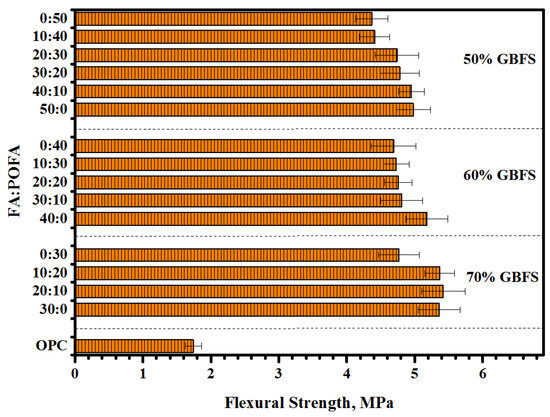
Figure 13.
Three-point load FS for GPMs made using high GBFS levels.
3.4. Compressive Strength (CS)
Figure 14 shows the effect of high volume GBFS on the CS of the prepared mortars. An increasing content of GBFS showed a positive effect on the compressive strength. Figure 15a displays the influence of GBFS replacement with FA. As the GBFS levels increased from 50 to 70%, the early age (1 day) strength of the mixes also increased from 38.71 to 40.1 MPa, respectively. Similar trends in compressive strength developments were observed at ages of 3, 7, and 28 days. The test results of CS were 80.5, 80.7, and 85.1 MPa at an age of 28 days, when the corresponding levels of GBFS increased to 50, 60, and 70%. The CS gain of specimens containing high volumes of GBFS were 45, 61, 75, and 90% from the final strength at 1, 3, 7, and 28 days, respectively. Figure 15b shows the effect of increasing the GBFS levels by replacing them with POFA on the CS development of GPMs. The observed CS values were directly proportional to the GBFS levels including POFA. The early strength of the mortars after 24 h improved with the increase in GBFS levels and a reduction in POFA contents. The CS values of the mortars increased from 18.7 to 26.0 MPa with the corresponding increase in GBFS levels from 50 to 70%. The CS at other ages revealed similar trends to early age curing. The CS values varied from 55.6 to 70.5 MPa at 28 days. The specimens prepared with high volumes of GBFS as a substitute to POFA displayed a gain in the CS, ranging from 29 to 78% from the final strength at the ages of 1 to 28 days, respectively.
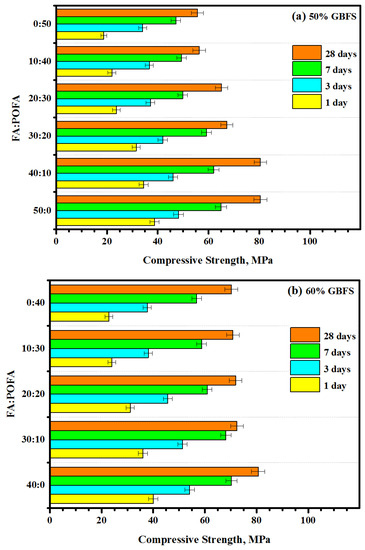
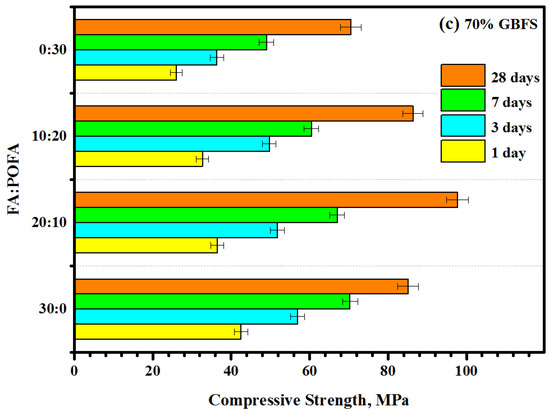
Figure 14.
Influence of high volumes of GBFS (a) 50%, (b) 60%, and (c) 70% on compressive strength of mortars incorporating FA and POFA.
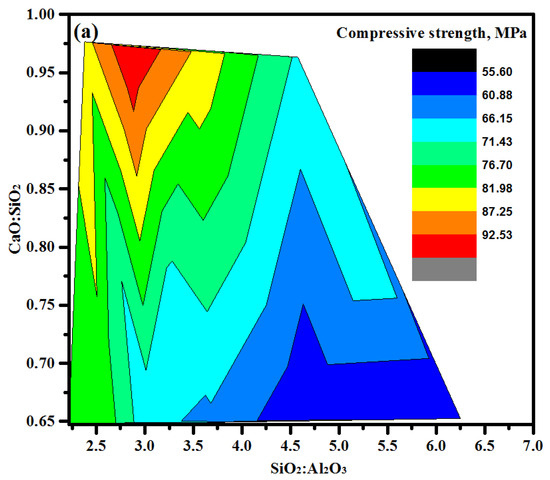
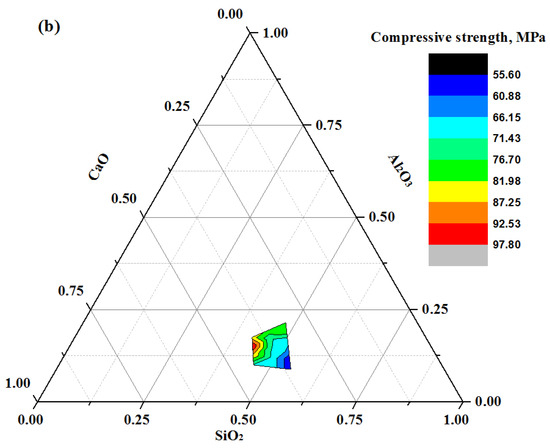
Figure 15.
Effect of (a) CaO:SiO2, (b) SiO2, Al2O3, and CaO contents on the CS of mortars made with high volumes of GBFS at age of 28 days.
It is established that GBFS possesses a glassy and granular material consisting of SiO2, CaO, Al2O3, and MgO, wherein a high calcium oxide (51.8%) content enabled the formation of hydrated C-S-H gels as a major reaction product at a Ca to silica ratio of 1.68 [38]. The presence of C-S-H gel could further improve the CS of GPMs [38,51,52]. According to Kumar et al. [53], the hydration reaction can be predominated by C-S-H gels dissolution and precipitation because of the alkaline activation process of GBFS at ambient temperatures. The improvement in the setting time and CS can be explained by the formation of cementitious C-S-H gel, which improved the hardening of GPMs. The effect of GBFS content on the CS development was examined [37], wherein at the early ages, the CS of GPM showed improvement with an increase in GBFS content. Shen et al. [54] studied the effects of various GBFS contents on the CS development of GPMs and found an improvement in both the CS and FS with increasing GBFS levels. It was argued that a GBFS addition could accelerate the hydration reaction, thereby, the formation of C-S-H gel products [55]. An increasing level of GBFS can appreciably speed up the hydration reaction, thus improving the CS development of GPMs. The impact of GBFS-mediated gel formation was interpreted using various processes. Firstly, the improved CS for a higher amount of C-S-H gel formation was due to the inclusion of dissolved CaO from the GBFS surface [53,56], wherein the higher production rate of C-S-H gel can cause water shortage in the mortar matrix, increasing the alkalinity and resulting in a higher dissolution of accessible alumina-silicates [57]. Secondly, the alkali-activated products from GBFS can produce more (C-A-S-H) gels, whereby the presence of excess Al ions may enhance the geopolymerization reaction rate, thus yielding a significant cross-linking amid C-S-H chains [58]. Furthermore, the production of (N-A-S-H) gels may be the third factor for the improvement of mortar’s CS. Certainly, N-A-S-H gel being the insignificant secondary product that coexists in the composition range of the major C-S-H gel [59] can increase the compactness of the produced gel, thus reducing the overall porosity and improving the CS of GPMs [60].
As shown in Figure 14c, the specimens prepared with high contents of GBFS and FA revealed higher CS than those containing GBFS and POFA. At an age of 28 days, CS values of 80.5, 80.7, and 85.1 MPa were achieved for GPMs containing GBFS and FA. However, GPMs containing GBFS and POFA revealed CS values of 55.6, 70.2, and 70.5 MPa, which were lower than the previous mixes. The effects of POFA on CS can clearly be observed in Figure 14b at an early age. The CS gain of the GPM after 24 h reduced to 29% and 45% for the blends containing POFA and FA, respectively. Similar trends in CS were observed at ages of 3, 7, 28, 56, and 90 days, whereas the CS gain with FA was still higher than the one with POFA. A higher ratio of silica to aluminum (6.25) was achieved for the matrix containing 50% POFA compared to a ratio of 2.2 for the matrix containing 50% FA, which reduced the CS from 80.5 to 55.6 MPa at the age of 28 days. According to Ranjbar et al. [29], increasing the silica to alumina ratio may negatively affect the CS development of GPMs. In addition to this, a decrease in the Al concentration with an increase in the POFA level can significantly effect the C-A-S-H product’s formation, thus lowering the CS of mortars [30] and slowing down the hydration reaction rate.
The effects of high volume GBFS on the CS of mortars at various ratios of FA:POFA are shown in Figure 14. The mortar mix made by using 70% GBFS showed a reduction in the ratio of FA:POFA from 30:0 to 0:30, and has negatively affected the strength gain at early ages of 1, 3 and 7 days, as shown in Figure 14a. The values of compressive strength were observed to be 42.5, 36.5, 32.7, and 26 MPa for POFA contents of 0 to 10, 20, and 30%, respectively. Low contents of Al2O3 negatively affected the early age strength of GPM [58,59,60,61,62]. At an age of 28 days, the CS increased from 85.1 MPa to 97.8 MPa with increasing POFA contents from 0% to 10% as an FA replacement. An increase in the POFA content from 20 to 30% reduced the strength from 86.5 and 70.5 MPa, respectively. The effect of POFA in place of FA on the CS of GPMs containing 60 and 50% of GBFS is shown in Figure 14b,c, respectively. With increasing POFA levels, the CS at early ages was reduced. Ariffin et al. [63] reported that the low contents of Al2O3 were responsible for the reduced compressive strengths, which were attributed to the incomplete geopolymerization reaction because Al2O3 showed a higher dissolution rate in early phases of the geopolymerization process.
Figure 15 shows the effect of silica to aluminum (SiO2:Al2O3) and calcium to silica ratios (CaO:SiO2) on the compressive strengths of GPMs containing high volumes of GBFS. The compressive strengths of GPMs were appreciably influenced by the increase in such ratios. The highest strength (above 80 MPa) was obtained when the ratio of CaO:SiO2 was above 0.8 and SiO2:Al2O3 was below 3.5. However, the CS of the mortars was inversely related to the SiO2 to Al2O3 ratio with the optimal value of 55.6 MPa at the ratio of 6.5 (Figure 15a). The CS of mortar mixes at an age of 28 days reached a maximum value of 97 MPa for a CaO to SiO2 ratio of 0.97. SiO2 to Al2O3 ratios of 2.75 and 3.25 reduced the corresponding CS values of GPMs at an age of 28 days to 86.4 and 85.1 MPa (Figure 15b), respectively. It was demonstrated that as the silica percentage content increased and calcium and aluminium contents decreased, the compressive strength of GPMs reduced.
3.5. X-ray Diffraction Analysis
Figure 16 shows the influence of a high-volume GBFS (70%) incorporating FA and POFA at 28 days of curing age. An increasing amount of GBFS enhanced the albite peak intensity and reduced the quartz peak intensity. GPMs with increasing contents of GBFS (60 and 70%) and decreasing contents of POFA (40 and 30%) revealed new peaks, such as calcite and gismondine, in addition to the albite gel peak. The formation of dense gel product led to the enhancement of the GPM surface structure and strength from 63.2 to 73.1 and 76.9 MPa. The gel peaks verified the presence of calcium in chemical composites such as calcite, gismondine and albite for 0 and 10% of POFA replaced FA. The albite peak at 31° for 10% of POFA showed a higher intensity and lower width than a similar peak at 0% of POFA, implying that the C-S-H product in 10% POFA was higher than the one made without POFA. This explained the improved CS of mortars to 97.7 MPa compared to 85.1 MPa recorded without FOFA. When the POFA level in place of FA was raised to 20%, some of the peaks were altered, where a mullite peak replaced the calcite at 36° and nepheline replaced the ettringite peak at 34°, leading to a reduction in the strength of the GPM from 97.7 to 86.4 MPa [49].
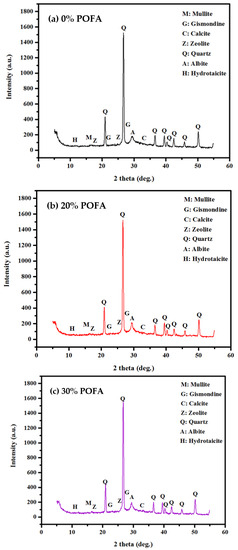
Figure 16.
XRD spectra of high volume GBFS (70%) containing various levels of POFA as FA replacement (a) 0%, (b) 20%, and (c) 30%.
3.6. SEM Images
To compare the microstructure of GBFS blended mixes containing FA, three levels of high-volume GBFS specimens were prepared. Figure 17 presents the SEM results for 70% GBFS and POFA as FA replacement at 28 days of age. As seen in the SEM images, the dense gel increased with the increasing contents of GBFS. Generally, with the increase in GBFS level, the C-S-H gel products were also increased, thus enhancing the microstructures of the mortars [61,62,63,64]. Figure 17a shows the SEM image of GPM containing 70% GBFS. Most of the sample surface appeared dense in the presence of a small quantity of particles that did not react at all or reacted partially. Figure 17b shows the SEM images of mortar microstructures when FA was replaced by POFA at 70% of GBFS. With decreasing levels of GBFS, partially reacted and unreacted particles in the mortar increased, indicating a less compact and highly porous surface of the mortar than the one made with 70% of GBFS only. Furthermore, SEM images showed that the substitution of GBFS by 30% of FA could enhance the microstructures of the alkali-activated matrix wherein the mortar’s surface became less porous and more compact than the one made using 30% of POFA. The SEM image of the specimen composed of 30% of POFA displayed an abundance of FA particles that underwent a partial or no reaction. The non-reacted or partially reacted particles were rarely observed on the GPMs surface with a low amount of POFA. The CS and microstructures of the proposed GPM were found to rely mainly on the SiO2 to Al2O3 ratio [65], wherein a ratio over 3.50 was found to negatively influence the mortar’s CS and microstructures [66].
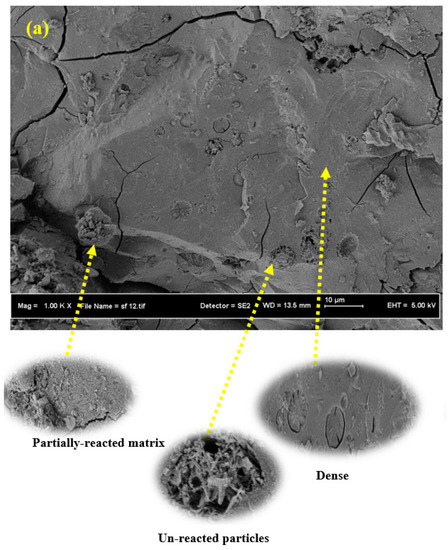
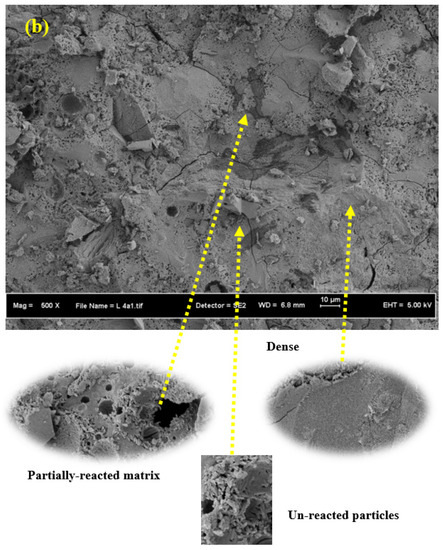
Figure 17.
SEM images of geopolymers made with 70% of GBFS, (a) 30% FA and (b) 30% POFA [49].
3.7. FTIR Analysis
Figure 18 shows the FTIR spectrum of GPMs prepared using various GBFS levels (50, 60, and 70%). Mortars containing 50, 60, and 70% of GBFS showed significant IR bands at 755.3 cm−1, 871.5 cm−1, and 945.6 cm−1; 743.7 cm−1, 865.6 cm−1, and 945.1 cm−1; and 730.1 cm−1, 865.1 cm−1, and 944.4 cm−1, respectively. The observed reduction in frequency with an increase in GBFS content was responsible for the increase in the CS of GPMs from 80.5 to 85.1 MPa. The creation of hydration reaction products like AlO4, C-S-H, and C-(N)-A-S-H were inversely related to the wavenumber, wherein a small wavenumber suggested the dissolution of more SiO2, enabling the formation of more reaction gel products [67,68]. Comparable results were obtained for GPMs made with GBFS in place of POFA at 50, 60, and 70%, wherein an increasing GBFS content could reduce the band wavenumber. This observation was attributed to the production of more dense gels of C-S-H and C-(N)-A-S-H. The achievement of the GPMs low strength with POFA incorporation, rather than FA inclusion, was explained using a FTIR analysis. With increasing POFA concentration, the Al2O3 content in the mortar could be reduced with the dissolution of silicate and leads to a drop in the gel formulation. Consequently, AlO4, C-S-H, and C-(N)-A-S-H products were decreased, which showed that the wavenumbers of POFA-included mixes were different than the ones made with FA incorporation. The FTIR spectra of the mortar mix made with 50% of GBFS and POFA replaced by FA was also recorded. The wavenumber of Si-O-Al was enhanced with the increase in POFA content from 0 to 50%, in which case the corresponding CS values were reduced from 80.5 to 55.6 MPa.
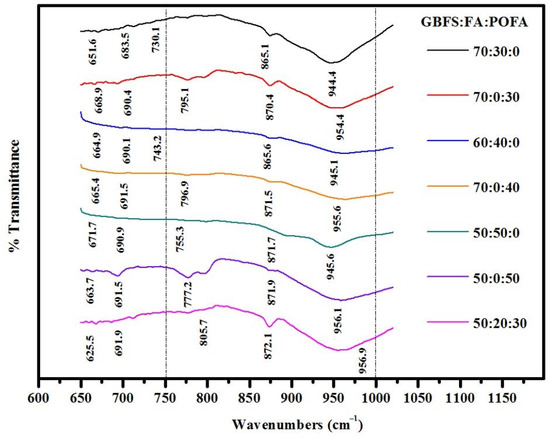
Figure 18.
FTIR spectra of GPMs made using high levels of GBFS incorporating FA and POFA at 28 days of curing age.
4. Conclusions
Based on the present findings on the bond strength of prepared geopolymers as repair materials, the following conclusions could be drawn:
- i.
- In the slant shear, splitting tensile, flexural strength, and bending stress tests, the geopolymers showed excellent performance in terms of bond strength between them and the concrete substrate.
- ii.
- Proposed mortars containing a high volume of GBFS (70%) presented the optimum value of bond strength. With increasing GBFS levels, more silicate was dissolved, thus improving the reaction rate to form more C-S-H gel.
- iii.
- Increasing the contents of POFA up to 50% in ternary-blended geopolymers reduced the bond strength more than 30%, as compared to other levels of POFA and FA contents.
- iv.
- Most geopolymer mixtures prepared with a high volume of FA presented an excellent bond strength which could be attributed to the low ratio of silica to aluminum as compared to POFA matrixes.
- v.
- The bond strength between geopolymers and the concrete substrate in critical condition (30° slant shear) presented excellent results.
- vi.
- The strength development of mortar mixes was influenced by the GBFS content, where the highest values of strength were recorded at its maximum level. At an early age, the high content (50%) of FA and POFA negatively effected the compressive strength values. The gain in compressive strength at an age of 28 days was negatively influenced with increasing contents of POFA. Most geopolymer specimens achieved a gain in the compressive strength between 81 and 94% at 28 days of curing age.
- vii.
- The results of bond strength including slant shear, splitting tensile, and flexural strength were observed to be directly proportional to the compressive strength.
- viii.
- The in-depth XRF, SEM, and FTIR analyses confirmed the achieved compressive strength improvement of geopolymers due to GBFS inclusion at low sodium hydroxide and sodium silicate molarity.
- ix.
- Based upon the mechanical test results data, a mixture containing 70% GBFS, 20% FA, and 10% of POFA is recommended as the optimum mix of repair materials.
- x.
- It is recommended to evaluate the effect of FA and POFA incorporating high volumes of GBFS on the proposed mortar’s durability performance. An evaluation of durability is the prerequisite for a broad range of applications in the construction sector.
- xi.
- In summary, there are possibilities to produce high performance geopolymer mortars using ternary blends of GBFS, FA, and POFA for several applications of repair in the construction industry.
5. Patents
This section is not mandatory but may be added if there are patents resulting from the work reported in this manuscript.
Author Contributions
Conceptualization, G.F.H. and Z.K.; methodology, G.F.H. and Z.J.H.; software, Z.K. and B.M.N.; validation, Z.J.H., Z.K. and G.F.H.; formal analysis, G.F.H. and B.M.N.; investigation, Z.J.H.; resources, G.F.H.; data curation, B.M.N.; writing—original draft preparation, G.F.H.; writing—review and editing, J.M.; visualization, J.M.; supervision, J.M.; project administration, Z.K.; funding acquisition, G.F.H. All authors have read and agreed to the published version of the manuscript.
Funding
Authors thank South Ural State University for their support and cooperation to conduct this research.
Data Availability Statement
Data sharing not applicable.
Conflicts of Interest
The authors declare no conflict of interest.
Abbreviations
| GPMs | geopolymer mortars |
| GPs | geopolymers |
| OPC | ordinary Portland cement |
| FA | fly ash |
| POFA | palm oil fuel ash |
| GBFS | ground blast furnace slag |
| ASs | aluminum silicates |
| NH | sodium hydroxide |
| NS | sodium silicate |
| NC | normal concrete |
| LOI | loss on ingnition |
| B | binders |
| A | aggregates |
| FS | flexural strength |
| STS | splitting tensile strength |
| CS | compressive strength |
| SSBS | slant shear bond strength |
References
- Huseien, G.F.; Mirza, J.; Ismail, M.; Ghoshal, S.K.; Hussein, A.A. Geopolymer mortars as sustainable repair material: A comprehensive review. Renew. Sustain. Energy Rev. 2017, 80, 54–74. [Google Scholar] [CrossRef]
- Hamzah, H.K.; Huseien, G.F.; Asaad, M.A.; Georgescu, D.P.; Ghoshal, S.K.; Alrshoudi, F. Effect of waste glass bottles-derived nanopowder as slag replacement on mortars with alkali activation: Durability characteristics. Case Stud. Constr. Mater. 2021, 15, e00775. [Google Scholar] [CrossRef]
- Balaguru, P. Geopolymer for Protective Coating of Transportation Infrastructures; Dept. of Transportation: Trenton, NJ, USA, 1998.
- Zhang, Z.; Yao, X.; Wang, H. Potential application of geopolymers as protection coatings for marine concrete III. Field experiment. Appl. Clay Sci. 2012, 67, 57–60. [Google Scholar] [CrossRef]
- Zhang, Z.; Yao, X.; Zhu, H. Potential application of geopolymers as protection coatings for marine concrete: II. Microstructure and anticorrosion mechanism. Appl. Clay Sci. 2010, 49, 7–12. [Google Scholar] [CrossRef]
- Geissert, D.G.; Li, S.E.; Franz, G.C.; Stephens, J.E. Splitting prism test method to evaluate concrete-to-concrete bond strength. ACI Mater. J. 1999, 96, 359–366. [Google Scholar]
- Momayez, A.; Ehsani, M.R.; Ramezanianpour, A.A.; Rajaie, H. Comparison of methods for evaluating bond strength between concrete substrate and repair materials. Cem. Concr. Res. 2005, 35, 748–757. [Google Scholar] [CrossRef]
- Hardjito, D.; Wallah, S.E.; Sumajouw, D.M.J.; Rangan, B.V. Introducing fly ash-based geopolymer concrete: Manufacture and engineering properties. In Proceedings of the 30th Conference on our World in Concrete and Structures, Singapore, 23–24 August 2005. [Google Scholar]
- Nath, P.; Sarker, P.K. Use of OPC to improve setting and early strength properties of low calcium fly ash geopolymer concrete cured at room temperature. Cem. Concr. Compos. 2015, 55, 205–214. [Google Scholar] [CrossRef]
- Han, Q.; Wang, A.; Zhang, J. Research on the early fracture behavior of fly ash-based geopolymers modified by molybdenum tailings. J. Clean. Prod. 2022, 365, 132759. [Google Scholar] [CrossRef]
- Rafieizonooz, M.; Mirza, J.; Salim, M.R.; Hussin, M.W.; Khankhaje, E. Investigation of coal bottom ash and fly ash in concrete as replacement for sand and cement. Constr. Build. Mater. 2016, 116, 15–24. [Google Scholar] [CrossRef]
- Chinnu, S.; Minnu, S.N.; Bahurudeen, A.; Senthilkumar, R. Influence of palm oil fuel ash in concrete and a systematic comparison with widely accepted fly ash and slag: A step towards sustainable reuse of agro-waste ashes. Clean. Mater. 2022, 5, 100122. [Google Scholar] [CrossRef]
- Fernando, S.; Gunasekara, C.; Law, D.W.; Nasvi, M.C.M.; Setunge, S.; Dissanayake, R. Engineering properties of waste-based alkali activated concrete brick containing low calcium fly ash and rice husk ash: A comparison with traditional Portland cement concrete brick. J. Build. Eng. 2022, 46, 103810. [Google Scholar] [CrossRef]
- Perez, O.F.A.; Florez, D.R.; Vergara, L.M.Z.; Benavides, K.V.H. Innovative use of agro-waste cane bagasse ash and waste glass as cement replacement for green concrete. Cost analysis and carbon dioxide emissions. J. Clean. Prod. 2022, 379, 134822. [Google Scholar] [CrossRef]
- Huseien, G.F.; Hamzah, H.K.; Sam, A.R.M.; Khalid, N.H.A.; Shah, K.W.; Deogrescu, D.P.; Mirza, J. Alkali-activated mortars blended with glass bottle waste nano powder: Environmental benefit and sustainability. J. Clean. Prod. 2020, 243, 118636. [Google Scholar] [CrossRef]
- Mhaya, A.M.; Baharom, S.; Baghban, M.H.; Nehdi, M.L.; Faridmehr, I.; Huseien, G.F.; Algaifi, H.A.; Ismail, M. Systematic Experimental Assessment of POFA Concrete Incorporating Waste Tire Rubber Aggregate. Polymers 2022, 14, 2294. [Google Scholar] [CrossRef]
- Dobiszewska, M.; Bagcal, O.; Beycioğlu, A.; Goulias, D.; Köksal, F.; Płomiński, B.; Ürünveren, H. Utilization of rock dust as cement replacement in cement composites: An alternative approach to sustainable mortar and concrete productions. J. Build. Eng. 2023, 69, 106180. [Google Scholar] [CrossRef]
- Tunc, E.T. Recycling of marble waste: A review based on strength of concrete containing marble waste. J. Environ. Manag. 2019, 231, 86–97. [Google Scholar] [CrossRef]
- Attri, G.K.; Gupta, R.; Shrivastava, S. Sustainable precast concrete blocks incorporating recycled concrete aggregate, stone crusher, and silica dust. J. Clean. Prod. 2022, 362, 132354. [Google Scholar] [CrossRef]
- D’Angelo, G.; Fumo, M.; Merino, M.D.R.; Capasso, I.; Campanile, A.; Iucolano, F.; Caputo, D.; Liguori, B. Crushed Bricks: Demolition Waste as a Sustainable Raw Material for Geopolymers. Sustainability 2021, 13, 7572. [Google Scholar] [CrossRef]
- Huseien, G.F.; Mirza, J.; Ismail, M.; Hussin, M.W. Influence of different curing temperatures and alkali activators on properties of GBFS geopolymer mortars containing fly ash and palm-oil fuel ash. Constr. Build. Mater. 2016, 125, 1229–1240. [Google Scholar] [CrossRef]
- Huseien, G.F.; Shah, K.W. Durability and life cycle evaluation of self-compacting concrete containing fly ash as GBFS replacement with alkali activation. Constr. Build. Mater. 2020, 235, 117458. [Google Scholar] [CrossRef]
- Awal, A.A.; Hussin, M.W. The effectiveness of palm oil fuel ash in preventing expansion due to alkali-silica reaction. Cem. Concr. Compos. 1997, 19, 367–372. [Google Scholar] [CrossRef]
- Alengaram, U.J.; Mahmud, H.; Jumaat, M. Enhancement and prediction of modulus of elasticity of palm kernel shell concrete. Mater. Des. 2011, 32, 2143–2148. [Google Scholar] [CrossRef]
- Ismail, M.; Yusuf, T.O.; Noruzman, A.H.; Hassan, I.O. Early strength characteristics of palm oil fuel ash and metakaolin blended geopolymer mortar. Adv. Mater. Res. 2013, 690, 1045–1048. [Google Scholar] [CrossRef]
- Kong, D.L.; Sanjayan, J.; Sagoe-Crentsil, K. Comparative performance of geopolymers made with metakaolin and fly ash after exposure to elevated temperatures. Cem. Concr. Res. 2007, 37, 1583–1589. [Google Scholar] [CrossRef]
- Awal, A.A.; Hussin, M.W. Effect of palm oil fuel ash in controlling heat of hydration of concrete. Procedia Eng. 2011, 14, 2650–2657. [Google Scholar] [CrossRef]
- Ranjbar, N.; Mehrali, M.; Alengaram, U.J.; Metselaar, H.S.C.; Jumaat, M.Z. Compressive strength and microstructural analysis of fly ash/palm oil fuel ash based geopolymer mortar under elevated temperatures. Constr. Build. Mater. 2014, 65, 114–121. [Google Scholar] [CrossRef]
- Ranjbar, N.; Mehrali, M.; Behnia, A.; Alengaram, U.J.; Jumaat, M.Z. Compressive strength and microstructural analysis of fly ash/palm oil fuel ash based geopolymer mortar. Mater. Des. 2014, 59, 532–539. [Google Scholar] [CrossRef]
- Mijarsh, M.; Johari, M.; Ahmad, Z. Compressive strength of treated palm oil fuel ash based geopolymer mortar containing calcium hydroxide, aluminum hydroxide and silica fume as mineral additives. Cem. Concr. Compos. 2015, 60, 65–81. [Google Scholar] [CrossRef]
- Ye, H.; Cartwright, C.; Rajabipour, F.; Radlińska, A. Understanding the drying shrinkage performance of alkali-activated slag mortars. Cem. Concr. Compos. 2017, 76, 13–24. [Google Scholar] [CrossRef]
- Prasittisopin, L.; Trejo, D. Effects of mixing time and revolution count on characteristics of blended cement containing rice husk ash. J. Mater. Civ. Eng. 2018, 30, 04017262. [Google Scholar] [CrossRef]
- Amer, I.; Kohail, M.; El-Feky, M.S.; Rashad, A.; Khalaf, M.A. Characterization of alkali-activated hybrid slag/cement concrete. Ain Shams Eng. J. 2021, 12, 135–144. [Google Scholar] [CrossRef]
- Aboulayt, A.; Souayfan, F.; Roziere, E.; Jaafri, R.; El Idrissi, A.C.; Moussa, R.; Justino, C.; Loukili, A. Alkali-activated grouts based on slag-fly ash mixtures: From early-age characterization to long-term phase composition. Constr. Build. Mater. 2020, 260, 120510. [Google Scholar] [CrossRef]
- Prasittisopin, L.; Trejo, D. Characterization of chemical treatment method for rice husk ash cementing materials. Spec. Publ. 2013, 294, 1–14. [Google Scholar]
- Phoo-ngernkham, T.; Sata, V.; Hanjitsuwan, S.; Ridtirud, C.; Hatanaka, S.; Chindaprasirt, P. High calcium fly ash geopolymer mortar containing Portland cement for use as repair material. Constr. Build. Mater. 2015, 98, 482–488. [Google Scholar] [CrossRef]
- Al-Majidi, M.H.; Lampropoulos, A.; Cundy, A.; Meikle, S. Development of geopolymer mortar under ambient temperature for in situ applications. Constr. Build. Mater. 2016, 120, 198–211. [Google Scholar] [CrossRef]
- Yip, C.K.; Lukey, G.; Van Deventer, J. The coexistence of geopolymeric gel and calcium silicate hydrate at the early stage of alkaline activation. Cem. Concr. Res. 2005, 35, 1688–1697. [Google Scholar] [CrossRef]
- Garcia-Lodeiro, I.; Palomo, A.; Fernández-Jiménez, A.; Macphee, D.E. Compatibility studies between N-A-S-H and C-A-S-H gels. Study in the ternary diagram Na2O–CaO–Al2O3–SiO2–H2O. Cem. Concr. Res. 2011, 41, 923–931. [Google Scholar] [CrossRef]
- Mirza, J.; Durand, B.; Bhutta, A.R.; Tahir, M.M. Preferred test methods to select suitable surface repair materials in severe climates. Constr. Build. Mater. 2014, 50, 692–698. [Google Scholar] [CrossRef]
- Hu, S.; Wang, H.; Zhang, G.; Ding, Q. Bonding and abrasion resistance of geopolymeric repair material made with steel slag. Cem. Concr. Compos. 2008, 30, 239–244. [Google Scholar] [CrossRef]
- Pacheco-Torgal, F.; Castro-Gomes, J.; Jalali, S. Adhesion characterization of tungsten mine waste geopolymeric binder. Influence of OPC concrete substrate surface treatment. Constr. Build. Mater. 2008, 22, 154–161. [Google Scholar] [CrossRef]
- Songpiriyakij, S.; Pulngern, T.; Pungpremtrakul, P.; Jaturapitakkul, C. Anchorage of steel bars in concrete by geopolymer paste. Mater. Des. 2011, 32, 3021–3028. [Google Scholar] [CrossRef]
- Suksiripattanapong, C.; Horpibulsuk, S.; Chanprasert, P.; Sukmak, P.; Arulrajah, A. Compressive strength development in fly ash geopolymer masonry units manufactured from water treatment sludge. Constr. Build. Mater. 2015, 82, 20–30. [Google Scholar] [CrossRef]
- Phoo-ngernkham, T.; Maegawa, A.; Mishima, N.; Hatanaka, S.; Chindaprasirt, P. Effects of sodium hydroxide and sodium silicate solutions on compressive and shear bond strengths of FA–GBFS geopolymer. Constr. Build. Mater. 2015, 91, 1–8. [Google Scholar] [CrossRef]
- Zhang, H.Y.; Kodur, V.; Qi, S.L.; Wu, B. Characterizing the bond strength of geopolymers at ambient and elevated temperatures. Cem. Concr. Compos. 2015, 58, 40–49. [Google Scholar] [CrossRef]
- Hawa, A.; Tonnayopas, D.; Prachasaree, W.; Taneerananon, P. Development and performance evaluation of very high early strength geopolymer for rapid road repair. Adv. Mater. Sci. Eng. 2013, 2013, 764180. [Google Scholar] [CrossRef]
- Mhaya, A.M.; Shahidan, S.; Zuki, S.S.; Huseien, G.F.; Azmi, M.A.; Ismail, M.; Mirza, J. Durability and Acoustic Performance of Rubberized Concrete Containing POFA as Cement Replacement. Sustainability. 2022, 14, 15510. [Google Scholar] [CrossRef]
- Huseien, G.F.; Khamehchi, M.; Kubba, Z.; Benjeddou, O.; Mahmoodi, M.J. Freeze-thaw cycle and abrasion resistance of alkali-activated FA and POFA-based mortars: Role of high volume GBFS incorporation. Heliyon 2023, 9, e17672. [Google Scholar] [CrossRef]
- Huseien, G.F.; Shah, K.W. Performance evaluation of alkali-activated mortars containing industrial wastes as surface repair materials. J. Build. Eng. 2020, 30, 101234. [Google Scholar] [CrossRef]
- Buchwald, A.; Hilbig, H.; Kaps, C. Alkali-activated metakaolin-slag blends—Performance and structure in dependence of their composition. J. Mater. Sci. 2007, 42, 3024–3032. [Google Scholar] [CrossRef]
- Pacheco-Torgal, F.; Castro-Gomes, J.; Jalali, S. Investigations on mix design of tungsten mine waste geopolymeric binder. Constr. Build. Mater. 2008, 22, 1939–1949. [Google Scholar] [CrossRef]
- Kumar, S.; Kumar, R.; Mehrotra, S. Influence of granulated blast furnace slag on the reaction, structure and properties of fly ash based geopolymer. J. Mater. Sci. 2010, 45, 607–615. [Google Scholar] [CrossRef]
- Shen, W.; Wang, Y.; Zhang, T.; Zhou, M.; Li, J.; Cui, X. Magnesia modification of alkali-activated slag fly ash cement. J. Wuhan Univ. Technol.-Mater. Sci. Ed. 2011, 26, 121–125. [Google Scholar] [CrossRef]
- Yu, R.; Spiesz, P.; Brouwers, H. Development of an eco-friendly Ultra-High Performance Concrete (UHPC) with efficient cement and mineral admixtures uses. Cem. Concr. Compos. 2015, 55, 383–394. [Google Scholar] [CrossRef]
- Nath, S.; Kumar, S. Influence of iron making slags on strength and microstructure of fly ash geopolymer. Constr. Build. Mater. 2013, 38, 924–930. [Google Scholar] [CrossRef]
- Khater, H. Effect of calcium on geopolymerization of aluminosilicate wastes. J. Mater. Civ. Eng. 2011, 24, 92–101. [Google Scholar] [CrossRef]
- Richardson, I.; Brough, A.R.; Groves, G.W.; Dobson, C.M. The characterization of hardened alkali-activated blast-furnace slag pastes and the nature of the calcium silicate hydrate (C-S-H) phase. Cem. Concr. Res. 1994, 24, 813–829. [Google Scholar] [CrossRef]
- Myers, R.J.; Bernal, S.A.; San Nicolas, R.; Provis, J.L. Generalized structural description of calcium–sodium aluminosilicate hydrate gels: The cross-linked substituted tobermorite model. Langmuir 2013, 29, 5294–5306. [Google Scholar] [CrossRef]
- Li, Z.; Liu, S. Influence of slag as additive on compressive strength of fly ash-based geopolymer. J. Mater. Civ. Eng. 2007, 19, 470–474. [Google Scholar] [CrossRef]
- Kabir, S.; Alengaram, U.J.; Jumaat, M.Z.; Sharmin, A.; Islam, A. Influence of molarity and chemical composition on the development of compressive strength in POFA based geopolymer mortar. Adv. Mater. Sci. Eng. 2015, 2015, 647071. [Google Scholar] [CrossRef]
- Islam, A.; Alengaram, U.J.; Jumaat, M.Z.; Bashar, I.I.; Kabir, S.A. Engineering properties and carbon footprint of ground granulated blast-furnace slag-palm oil fuel ash-based structural geopolymer concrete. Constr. Build. Mater. 2015, 101, 503–521. [Google Scholar] [CrossRef]
- Ariffin, M.; Hussin, M.W.; Rafique Bhutta, M.A. Mix design and compressive strength of geopolymer concrete containing blended ash from agro-industrial wastes. In Advanced Materials Research; Trans Tech Publications Ltd.: Stafa-Zurich, Switzerland, 2011; Volume 339, pp. 452–457. [Google Scholar]
- Nath, P.; Sarker, P.K. Effect of GGBFS on setting, workability and early strength properties of fly ash geopolymer concrete cured in ambient condition. Constr. Build. Mater. 2014, 66, 163–171. [Google Scholar] [CrossRef]
- Duxson, P.; Provis, J.L.; Lukey, G.C.; Van Deventer, J.S. The role of inorganic polymer technology in the development of ‘green concrete’. Cem. Concr. Res. 2007, 37, 1590–1597. [Google Scholar] [CrossRef]
- Chindaprasirt, P.; De Silva, P.; Sagoe-Crentsil, K.; Hanjitsuwan, S. Effect of SiO2 and Al2O3 on the setting and hardening of high calcium fly ash-based geopolymer systems. J. Mater. Sci. 2012, 47, 4876–4883. [Google Scholar] [CrossRef]
- Fernández-Jiménez, A.; Palomo, A. Mid-infrared spectroscopic studies of alkali-activated fly ash structure. Microporous Mesoporous Mater. 2005, 86, 207–214. [Google Scholar] [CrossRef]
- Huseien, G.F.; Faridmehr, I.; Nehdi, M.L.; Abadel, A.A.; Aiken, T.A.; Ghoshal, S.K. Structure, morphology and compressive strength of Alkali-activated mortars containing waste bottle glass nanoparticles. Constr. Build. Mater. 2022, 342, 128005. [Google Scholar] [CrossRef]
Disclaimer/Publisher’s Note: The statements, opinions and data contained in all publications are solely those of the individual author(s) and contributor(s) and not of MDPI and/or the editor(s). MDPI and/or the editor(s) disclaim responsibility for any injury to people or property resulting from any ideas, methods, instructions or products referred to in the content. |
© 2023 by the authors. Licensee MDPI, Basel, Switzerland. This article is an open access article distributed under the terms and conditions of the Creative Commons Attribution (CC BY) license (https://creativecommons.org/licenses/by/4.0/).